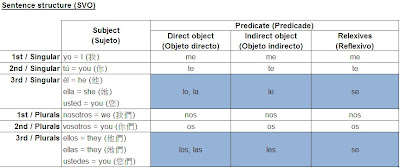- In general, Spanish follows the SVO pattern in English grammar.
- A few exceptions to the pattern: (a) An "inferrable" subject can be dropped, i.e. a subject that is originally a pronoun (b) A direct or an indirect object as a pronoun: comes after the subject but preceding the verb (c) Both direct and indirect objects as pronouns.
- In [2a]: VOiOd (where Oi refers to an indirect object and Od refers to a direct object.)
- In [2b]: {Sp}OpVOd or {Sp}OpV{Oi} (where {Sp} refers to a subject drop, which is optional; Op refers to an object, direct or indirect, as a pronoun; an indirect object is not compulsory, referred to as {Oi})
- In [2c]: to be completed.
- See ejercicios for [2b, 4], changing objects to pronoun, below:
- Notation: Verb/predicator, indirect object, direct object, adverb/adjunct
- Q1. Conozco a tu hermano. 我認識你的兄弟。
- A1. Lo Conozco.
- Q2. Ayer vi una pelicula. 我昨天看了一套電影。
- A2. {Ayer} La vi. / La vi {Ayer}.
- Q3. ¿Vendes tu casa? Si, vendo mi casa / No, no vendo mi casa.
- A3. ¿Vendes tu casa? Si, la vendo. / No, no la vendo.
- Q4







